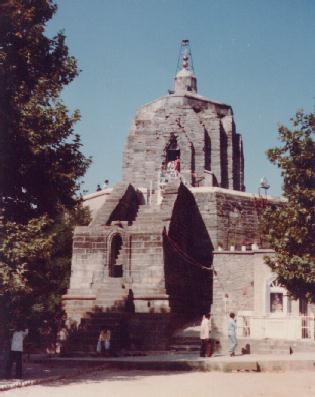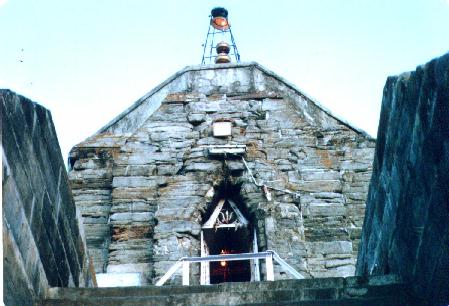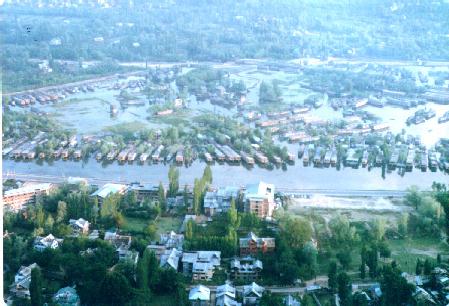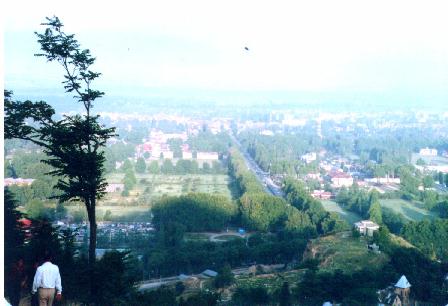ShankracharyaShankarachar
is a detached ridge of igneous rock to the south-east of Srinagar, separated
from the Shilamar Range by the Aita Gaj Gap. The summit of the hill is
crowned with a picturesque edifice. This hill was called Jetha Larak and
afterwards it was named Gopadari Hill. Some are of opinion that the temple
at the top was originally built by King Sandiman (2629-2564 B.c.). There
were 300 golden and silver images in it. About 1368 B.C. King Gopadittya
founder of Gopkar repaired it and bestowed to the Brahmans of Arya Varta,
agrahars which he built on its top. King Sandimati (34 B.C.-A.D. 13) improved
and added to the temple. Zain-Ul-Abdin (1421-1472 A.D.) repaired its roof
which had tumbled down by an earthquake. Sheikh Ghulam Mohi-Din, a Sikh
Governor (1841-46) also repaired its dome. Recently, the dome was repaired
by Swami Shivratnanand saraswati at the request of a Nepali Sadhu who gave
him financial aid.

The temple is under the control of the Dharmartha
Department. They have built two small buildings for the sadhus who live
there. There is at the place an old stone shed which is called 'Parvatihund
bana koth' (the store-house of goddess Parvati).

The present name owes its origin to the great
philosopher Shankaracharya who visited the valley about ten centuries ago,
and lodged at the top of this hill, where it appears there were small sheds
of Brahmans who looked after the temple. There is a small tank built of
slabs of stone just behind the temple. In those days the Acharya or the
Chief Preceptor or, in modern parlance, the Chancellor of the University
of Srinagar was Swami Abinaugupth. A discussion took place between the
two sages and according to the local tradition Abinaugupth initiated Shankaracharya
into the Shakti cult.
On the 20th April 1961 Shri Shankaracharia of
Dwarika Pet installed the white marble statue of Adi Shankaria just near
the temple arranged by the Dharmartha Department.

Shankracharya temple (viewed from the steps)
A climb to the hill from the Mission Hospital
(now Government Hospital for chest diseases) will take about 40 min. The
path is a pony-track. The descent towards the Gagribal spur is gentle.
En route is the tomb of Mian Dullo who is said to have squandered away
all the money which his father had given him to trade with. He was enamoured
of the charms of the Dal Lake which he selected as his favourite haunt
for the gratification of his epicurean appetites.
The panoramic view of the valley in early April
when the snow is deep on the mountains, or after rains on a summer day
from the summit of the hill is one of the best that could ever be witnessed.
The mountain ranges on the south, west and north rise one above the other
and the peaks, varying in height from 13,000-15,500 ft., jut out like the
teeth of a saw cutting through the sky. On the south lies the Banahal Pass
(9,250 ft.) the chief highway to Jummu, and a number of other passes and
depressions. The Brahma Shakri peaks, a group of grand cones viewed even
from Lahore, the Aliabad Pass (11,44o ft.) leading to Gujrat, the Romesh
Thong (Sunset) Peak, Tata Koti (15,540 ft.) guard the Chhoti Gali Pass
(14,450 ft.) the highest in the range, come one after another. We now turn
our eyes to the west where lies the vast plateau of Tosa Maidan, the paradise
of sheep, and where the eye meets the depression of Ferozpor leading into
Punch (Prunts) and Apharwat (13,542 ft.) giving shelter to Gulmarg and
affording thrilling sport for the votaries of skiing in India.

Beyond the Baramula Pass, towards the north-west,
the range is continued in Kaj Nag and Khagan mountain. In between the Tragbal
(9,500 ft.) and Zoji La (10,500 ft.) appears the beautiful candy cone of
Harmoukh (16,842 ft.) in the north, while the eastern range culminating
in Mahadiv (13,013 ft.) and Western peaks completes the enchanting circle.
At the foot of these mountains lie the alluvial plateaus with rich yellow
soil yielding maize and rice where water is available. The swamps, marshes
and lakes of the valleys stretch as far as the Wular Lake in the extreme
north of the valley. The Baramula road bordered with poplars, the sinuous
course of the Vetasta (Jhelum), cutting a clean almond called Shivapor Phur, the green house-tops now disappearing with the introduction of galvanised
iron sheets for roofs, the minarets of churches and mosques and the shining
surface of the temples present a picturesque sight.
Turning now to the Dal lake we see the Moghul
gardens of Nasim, Shalamar and Nishat densely shaded by the deep green
foliage of Boin (Chinar) trees, the floating gardens and the houses situated
on the islands in the lake encompassed by poplars, willows and quince trees.
The two expanses of deep blue water are separated by the causeway like
two great eyes, each with its pupil of an island. The eastern shore is
embellished by the magnificent Royal Palace with their crystal sheen, by
newly-laid gardens and the boulevard skirting it. A part of the palace
has been converted into a hotel with a superb view.

View of Srinagar city from Shankracharya temple
The Government has made the hill a resort and
it is hoped that it will one day be clothed with dense herbage and trees
Providing charming bowers for lovers. A number of paths has been marked
out and platforms with suitable seats have been made for visitors. In fact,
every effort is made to attract people to the hill.
In olden days a great festival used to be held
by the Hindus on the ioth day of the lunar fortnight of Baisak which corresponds
to March. Just above the Dal Gate they would come in doonga's to bathe.
This was called Monda daham, probably in memory of the killing of the demon
Mond by the goddess Sharika. But this festival has now been entirely forgotten
as if nothing like it ever existed.
Text by:
Samsar
Chand Koul
| 